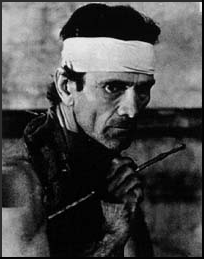Pasolini's View of the Decameron
The adaptation of Boccaccio's Decameron by Pier Paolo Pasolini has been debated regarding its faithfulness to the original text. His restructuring of Boccaccio's original frame and change in focus of the ten stories chosen and adapted for the film have engendered disapproval among literary and cinema critics, despite their acknowledgment that no work of literature can be perfectly replicated on screen.

Pasolini's intention was not to recreate the medieval world of Boccaccio's characters but instead to comment on contemporary Italian society through the metaphorical use of the original novellas of the Decameron. Pasolini dismantles the bourgeois frame of the brigata and replaces it with two subframes composed of modified novellas from the Decameron. By effecting this change, at least in his Ciappelletto subframe, Pasolini alters his characters' socio-economic point of view to support the Marxist dialectic which appears in all of his films. For example, Ciappelletto is not the uncultured degenerate of Boccaccio's elite narrator, but instead, from the point of view of the lower class, he appears as a victim of the bourgeois class's manipulation, much like the figure of Pasolini's Accattone who, not coincidentally, is portrayed by Franco Citti in both films. Pasolini's Ciappelletto is "sacrificed" and manipulated by the bourgeoisie, allowing the usurers to continue with their capitalist pursuits and the Church to appropriate his "good" reputation in order further to mislead the poorer classes through their naive and trusting religious devotion.
Pasolini chose particular stories from the Decameron to reverse Boccaccio's original intention and comment on the class conflict. For example, the juxtaposition of Ricciardo and Caterina's story and the novella of Elisabetta and Lorenzo underscores two distinct treatments of "punishment" for sexual transgression based on class considerations: Caterina's father forces the wealthy Ricciardo to marry her, while Lorenzo is killed for violating the honor of Elisabetta's (wealthier) family, for daring to rise above his class. Caterina's father, in a departure from Boccaccio's text, is no longer a knight but a member of a lower class, possibly a merchant, who takes economic advantage of his compromised honor, while Lorenzo is a Sicilian, not a Pisan as in the original, allowing Pasolini to state his position regarding the abuse of and disregard for southern Italy's poor by the northern bourgeois society. To further reinforce the idea of southern Italian poverty, Pasolini endowed his lower class and peasant characters with Neapolitan accents.
Boccaccio relied upon various sources for the Decameron, such as the French fabliaux tradition, contemporary chronicles, medieval romances, Italian folklore, exempla and others, in the same way that Pasolini's filmic text incorporates the original work with Marxist overtones and references to his past cinematic works. Boccaccio's Decameron was "popular" literature in the 14th century, although it may be difficult to imagine women, even in the privacy of their own homes, reading the risqué stories of Alatiel, Peronella, and Compare Pietro and his wife. The popularity of Pasolini's film inspired several equally bawdy spin-offs which, while taking similar advantage of Boccaccio's suggestive stories, completely omit the class-conscious messages intended by Pasolini in his work. Nonetheless, Pasolini's version of the Decameron, despite the controversy it generated, possibly did the most justice to Boccaccio's work simply by increasing the readership of the original text and encouraging rereadings of it.
(C. H.) Lawton, Ben, "Boccaccio and Pasolini: A Contemporary Interpretation of the Decameron." The Decameron: A New Translation, trans. and ed. by Mark Musa and Peter Bondanella (New York: W. W. Norton, 1977). pp. 306-322.